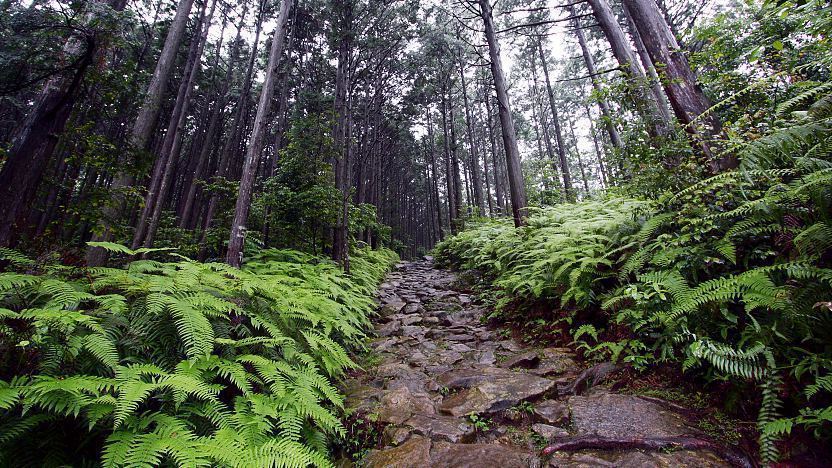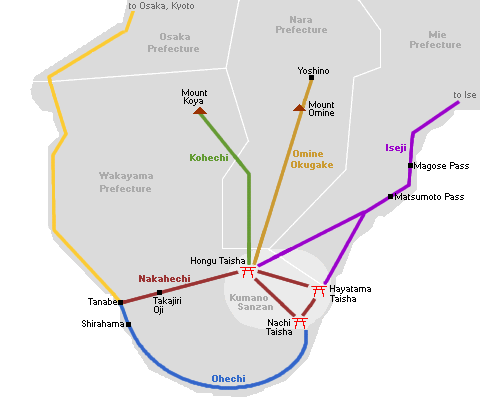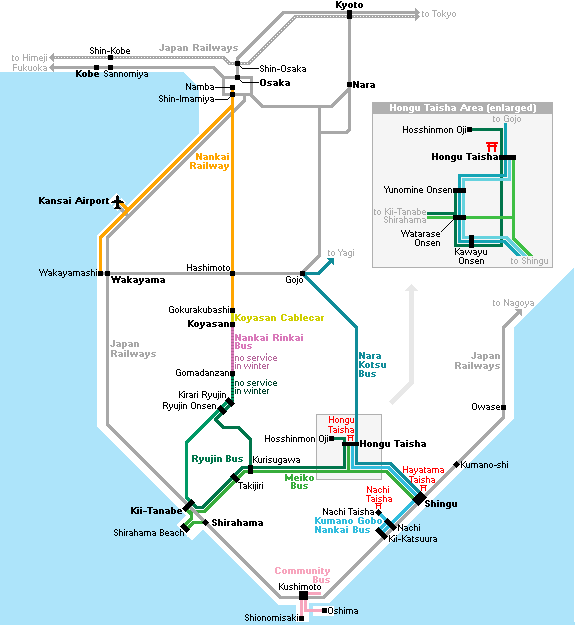Kumano Kodo Pilgrimage Trails

Kumano Kodo (熊野古道, Kumano Kodō) refers to a network of pilgrimage trails through the southern Kansai region. The Kodo ("old ways") are a key part of the region's World Heritage designation and have been in use for over 1000 years. They are the only pilgrimage routes besides the Camino de Santiago to be designated a World Heritage site.
The pilgrimage routes developed as a way for people to move between the sacred areas on the Kii Peninsula. At the center of this religious area are the three Kumano shrines: Hongu Taisha, Hayatama Taisha and Nachi Taisha, collectively known as Kumano Sanzan.
By the 12th century, the Kumano Sanzan were well known shrines in Japan, drawing pilgrims from Kyoto, Osaka and beyond. More than just a means to reach the three shrines, the pilgrimage trails were designed to be a religious experience in themselves and often pass through difficult, even dangerous, mountain terrain.

In addition to linking the shrines to one another, the Kodo pilgrimage trails link the Kumano area to Kyoto, Koyasan (the headquarter of Shingon Buddhism), Yoshino and Omine (centers of mountain worship) and Ise (Japan's most important shrine).
Today, most of the coastal trails have disappeared with development, but several mountain trails and passes remain. The trails are as follows:

Nakahechi is well preserved and relatively easy to walk, leading through hilly, forested landscapes and occasional villages. The section between Takijiri Oji (outside central Tanabe) and Hongu is about 30 kilometers, and can be done in a comfortable two days' walk with an overnight stop in Chikatsuya Oji, where there are a few minshuku. The trail ends with a descent into Hongu Taisha, offering a spectacular view of the shrine's massive torii gate.
Ohechi follows the coast from Tanabe to Nachi Taisha. This trail has virtually disappeared due to development and the construction of modern roads. At the height of its use between the 10th and 15th centuries, Ohechi, along with Nakahechi and Kohechi, is estimated to have seen the passage of over 30,000 people each year.
Iseji connects Kumano with Ise Shrine in Mie Prefecture. Like Ohechi, much of Iseji's coastal trail has been covered by paved roads and towns. Only short, isolated sections remain as stoned or earthen trails today. Among them, the Magose Pass in Owase City and Matsumoto Pass in Kumano City are some of the most picturesque.

Kohechi connects Kumano with Koyasan. This mountaintop route is long and challenging, and should not be undertaken without careful preparation. Inns are rarely found without zigzagging up and down the mountainsides into valley towns, greatly increasing the distance traveled. Kohechi was used mainly by monks from the temple complex of Mount Koya.
Omine Okugake connects Kumano with Yoshino via Mount Omine. Like Kohechi, Omine Okugake is a long, difficult and dangerous route that follows high mountain ridges and barely passes any towns for much of its duration. This route was used primarily by followers of the Shugendo mountain worship sect.

Getting there and around
Questions? Ask in our forum.
Links and Resources
English
Hotels around Kumano
-
-
![]() Kamenoi Hotel Nachi KatsuuraEnjoy open-air baths and freshly caught seafood at a traditional hot spring inn with ocean views. Only 30 minutes by bus from the UNESCO World Heritage Kumano Kodo Pilgrimage Routes.View siteSponsored
Kamenoi Hotel Nachi KatsuuraEnjoy open-air baths and freshly caught seafood at a traditional hot spring inn with ocean views. Only 30 minutes by bus from the UNESCO World Heritage Kumano Kodo Pilgrimage Routes.View siteSponsored
-




